It is no accident that there are three primary core diameters for fiber-optic cable. Over time physicists and materials scientists have determined that each type of data transmission via light has an ideal core diameter for that transmission type.
Single-Mode for Distance
The core diameter for single-mode fiber-optic cable is 8~10µm1. The ideal size is 8.3µm. This cable is also designated OM12.
For example the best carrier for voice communications is single-mode (SM) fiber though CATV (Cable TV) also uses this fiber type for long distance runs. Single-mode fiber works best with near-infrared3 wavelengths of light in the 1,300 to 1,550 nm (nanometer) ranges. In other words (see image right) the distance of the light wave from peak-to-peak is from 1,300 to 1,550 nanometers.
Longer wavelengths are possible with single-mode fiber up to and including 4,500nm. Roughly speaking, the higher the wavelength number (in nanometers) the greater the distance. Because these light cables have a narrow core and are typically used to transmit one wavelength of light the direction of transmission is one-way. For that reason single-mode fiber is generally installed with two fibers. One for each direction of transmission.
These longer wavelengths are what enable this fiber type to be used for such long distances. In fact, single-mode fiber can accurately transmit data up to fifty (50) times farther than multimode cable.
Because the near-infrared light generated for these cables is in the higher nanometer ranges and the core is so narrow the light-driver is typically a laser not an LED. (see last two images at right) A laser can produce a coherent beam or one that fits precisely into the narrow core without any of that light spilling over to the cladding.
Multimode for Multiplexing
The ideal diameter for multimode cable is 50µm; this is a drop from 62.5µm. There is still quite a bit of the larger core multimode cable out there, but the ideal size is now 50µm; this is for OM3 or OM42 cable. Multimode cable includes OM2 (62.5µm), OM3 (50µm) and OM4 (50µm laser optimized).
Multiplexing means that more than one signal is transmitted at the same time.
Multi-mode (MM), with it's larger core, allows for multiple wavelengths of light to be transmitted at the same time down the same cable. The light is "multiplexed" or joined together at the sending end and "demultiplexed" at the receiving end. MM cable typically carries 850, 1,310, and 1,550nm wavelength light.
These wavelengths are typically used for specific types of data transmission where 850nm is used for voice telephone, 1,300 ~ 1,310nm for video broadcast signals, and 1,500 ~ 1,510nm for Internet data transmission. The 1,550nm range is used to return transmission from the home/office to the central office.
In the consumer data transmission field using all three nanometer ranges for data transmission is called "triple-play."
To carry multiple signals the light pumped into this cable type is converted from the three wavelengths to a combined light signal via Wave Division Multiplexing (WDM).
Once the signal gets to the other end of the cable a de-multiplexer is employed to separate out the three original signals or wavelengths of light.
This is typically nothing more than a prism. The prism de-multiplexes the light at the receiving end of the cable and each beam of de-multiplexed light is directed to it's own media converter4, changing the light signal into three different wavelengths and then into three distinct electrical signals.
Mind the Gap
Notice in the figures above there are very definite gaps in the bandwidths. For example you do not see 1,100nm or 1,400 nm wavelengths. This is because the optical-fiber will absorb these two wavelengths and not transmit them.
Light Danger
Typically the light pumped into a fiber is beyond the range of human vision, just past the red end of the visible spectrum. (see second image right)
This does not make it less dangerous than visible light. Staring into the end of an active fiber optic cable cold cause retinal damage, so it is advisable to leave these cables well alone unless you have some assurance that the fiber you are examining is not active.


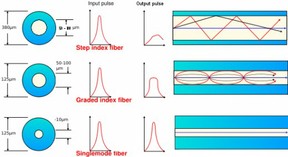
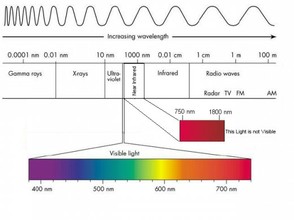
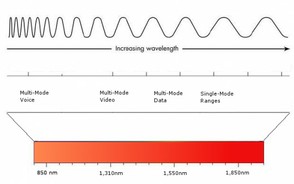



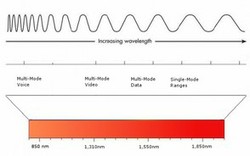

 Crêpes and Crêpe Disheson 09/14/2016
Crêpes and Crêpe Disheson 09/14/2016
 About Me - Liam Beanon 11/28/2014
About Me - Liam Beanon 11/28/2014
 About Ebolaon 11/08/2014
About Ebolaon 11/08/2014

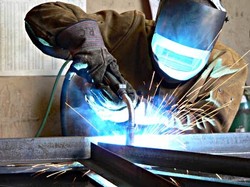
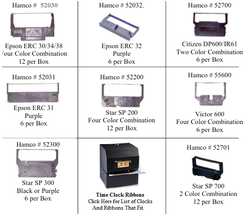
Comments
Thanks Angel!
Very interesting! I spent 20 years in the Power Generation (generators & back up power) industry so I am used to dealing with large multi-conductor power cables. I have often wished that I would have gone more into the Communications side of things instead of power. Never have dealt much with fiber optics. Great article!